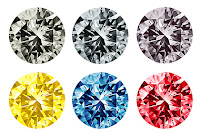“The ultimate gift of love that says so much will be cherished always, and lasts forever.”
Diamonds were first formed billions of years ago some 100 miles beneath the earth's surface through a process of tremendous pressure and temperatures of 2000 - 3000 degrees Fahrenheit. Volcanic activity brings diamond crystals much closer to the earth's surface.
The temperatures they are formed at are about 900 - 1300 C in this part of the Earth's mantle where diamonds form. The pressure is between 45 - 60 kilo bars. (kB) 50 kB = 150 km or 90 miles below the surface 60 kB = 200 km or 120 miles below the surface.
To produce a single one-carat diamond, 250 tons of earth will be mined.
Gem-quality diamonds are made up from less than 20 percent of the diamonds mined worldwide.The first written notation of precious diamonds dates back to around 500 B.C.In their purest state, diamonds are brilliant and entirely colorless.
Diamonds are found in a variety of colors. Blue and pink diamonds are among the rarest, and yellow and brown as among the most common.The diamond is the hardest natural substance found on the earth.
There are one or two things you should know before you jump into that diamond purchase. Okay, there are actually four things - Color, Cut, Clarity and Carat - better known as the 4 C's.These are the criteria jewelers use when grading diamonds, and they're the ones you'll need to understand to buy the right diamond for you.
And then there's the "Fifth C":
- Certificates
Cut
Cut is probably the most important, and most challenging, of the four Cs to understand. The brilliance of a diamond depends heavily on its cut.
Clarity
Most diamonds contain some inner flaws, or inclusions, that occur during the formation process. The visibility, number and size of these inclusions determine what is called the clarity of a diamond. Diamonds that are clear create more brilliance, and thus are more highly prized, and priced.
Color
Colorless diamonds are the most desirable since they allow the most refraction of light (sparkle). Off white diamonds absorb light, inhibiting brilliance.
Carat Weight
A carat is the unit of weight by which a diamond is measured. Because large diamonds are found less commonly than small diamonds, the price of a diamond rises exponentionaly to its size.
The Fifth C: Certificates
The diamond certificate, which is sometimes called a grading report, is a complete evaluation of your diamond that has been performed by a qualified professional with the help of special gemological instruments. Each stone bears its own recognizable, individual characteristics, which is listed on the certificate.












